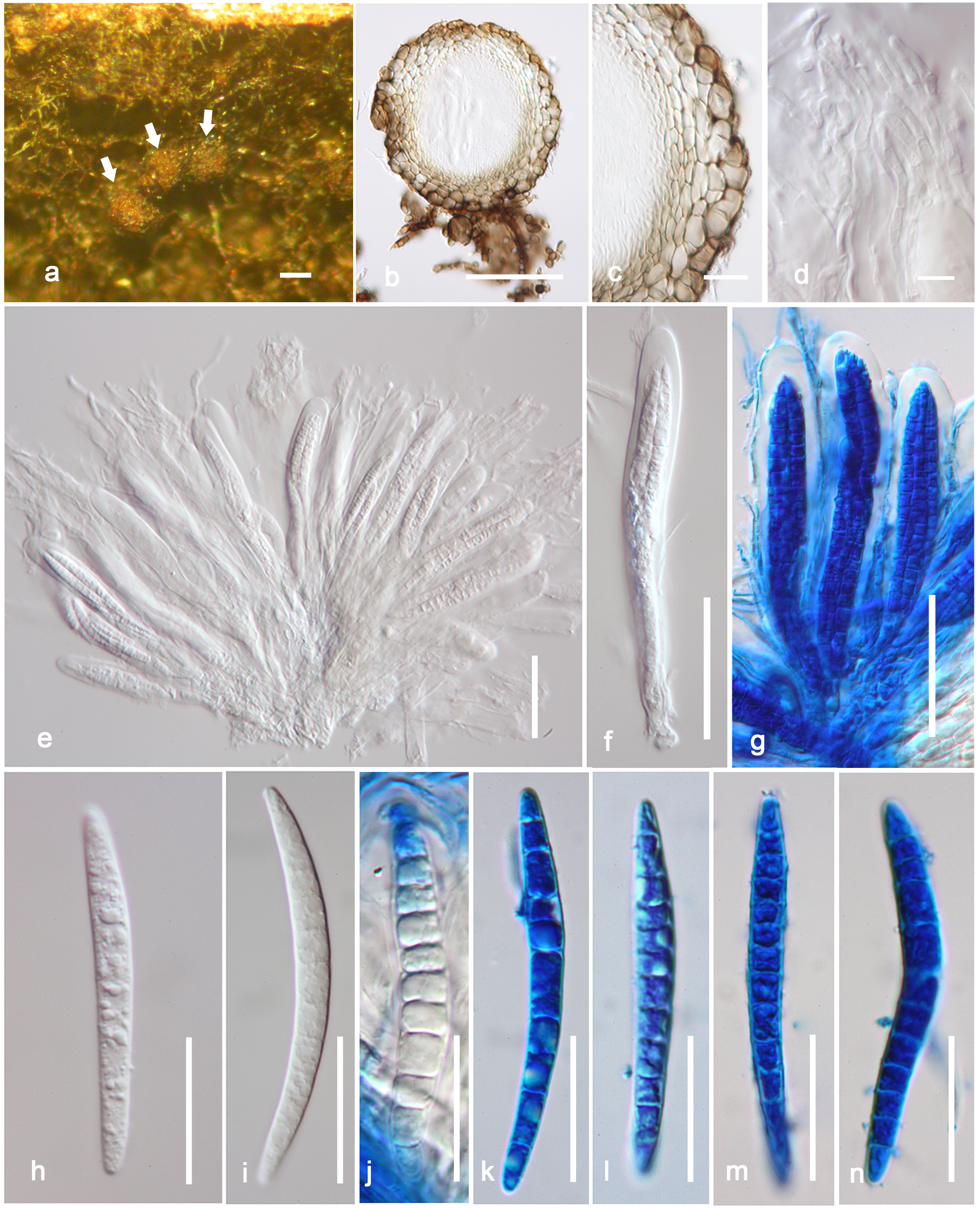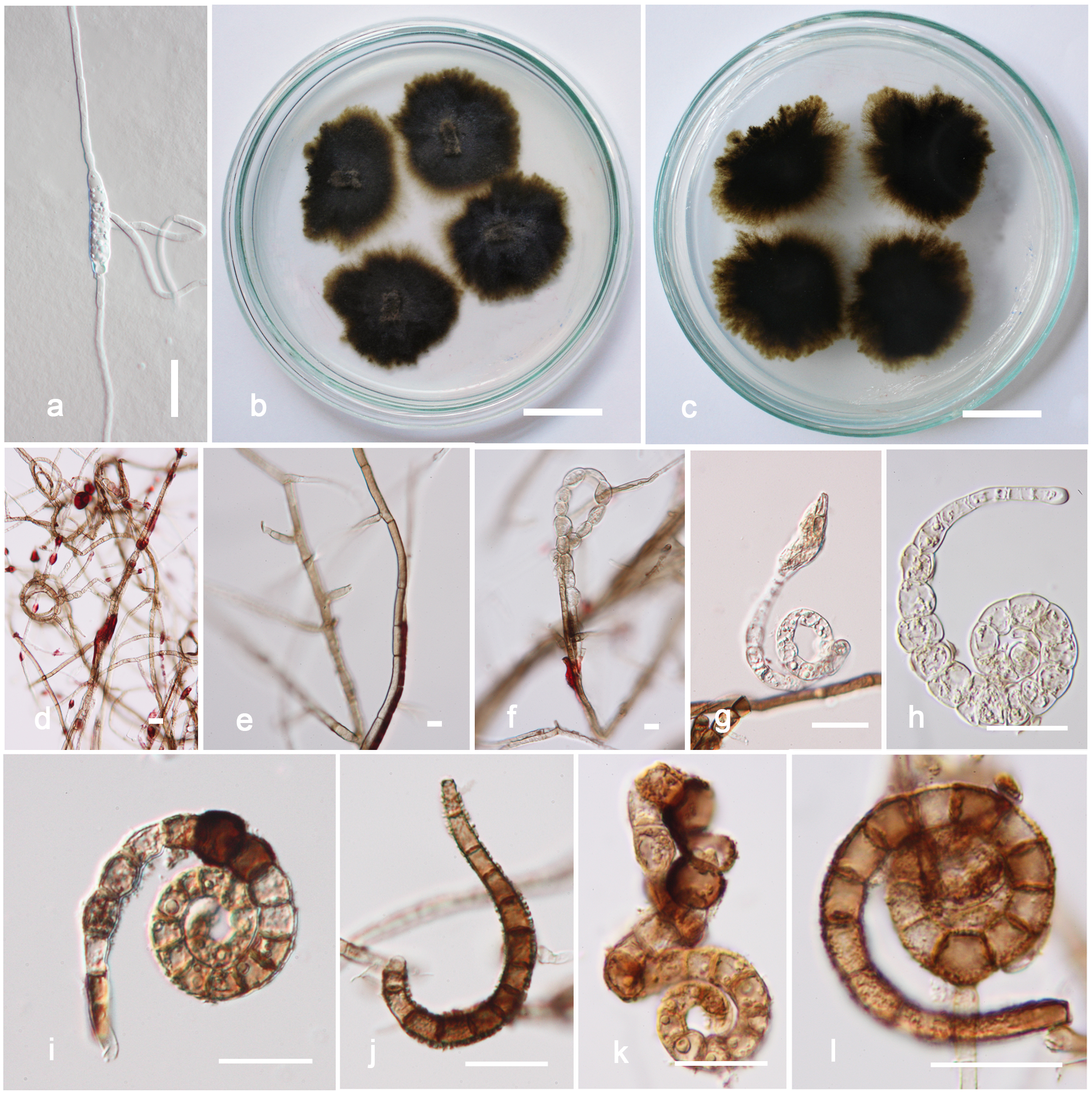Helicoma siamense Boonmee & K.D. Hyde, sp. nov.,MycoBank: MB 804557.
Etymology: in reference to its occurrence in Thailand (Siam).
Holotype: MFLU10–0053
Saprobic on dead wood. Sexual state:Ascomata 221–306 µm high × 180–268µm diam. ( = 270 × 233 µm), superficial, solitary, scattered, with basal subiculum, globose to subglobose, reddish-brown to dark brown, with a central ostiole, covered by brown mycelium, collapsing when dry. Peridium 30–48 µm wide, composed of several-layers of cells of textura angularis, with outer layer cells darkened and inner layer cells pale brown to hyaline. Hamathecium comprising numerous, wide, filiform,septate, branched, hyaline pseudoparaphyses. Asci (123-)127.5–139(-144) × (14-)17–20 µm ( = 133.5 × 18 µm, n = 20), 8-spored, bitunicate, cylindrical to clavate, short-pedicellate,with a rounded apex. Ascospores (49.5-)59–64.5(-68) × 5–7.5 µm ( = 62 × 6.5 µm, n = 20), overlapping 2–3-seriate, cylindric-fusiform, tapering towards rounded ends, widest at supramedian part, slightly curved, 11–12-septate, not constricted at septa, hyaline, smooth-walled. Asexual state: hyphomycetous, helicosporous. Conidiophores macronematous, 2–3 µm wide, erect, smooth, pale brown to brown, smooth. Conidiogenous cells holoblastic. Conidiahelicosporous, 24–36 µm diam. when coiled, filaments 7–10 µm wide, coiled 2–3 times, multiseptate, slightly constricted, darkened at septa, partly heavily pigmented, verrucose, rough-walled, brown to reddish-brown, narrow at base and wide at upper half on uncoiling.
Cultural characteristics: Ascospores germinating on MEA within 24–36 hours and germ tubes produced from many cells. Colonies growing on MEA slowly, 6 mm in 7 days at 28C, flat, sparsely hairy, fimbriate, dark brown. Mycelium partly superficial, partly immersed, composed of branched, septate, smooth, pale brown to reddish-brown, red pigmented hyphal filaments.
Material examined: THAILAND, Chiang Rai, Muang, Khun Korn Waterfall,elev. 671 msl., N19°51–54′ E 99°35.39′, on decaying wood of an unidentified tree, 13 November 2009, Saranyaphat Boonmee, KK-09 (MFLU10–0053, holotype;PDD 104454, isotype); ex-type living culture = MFLUCC10–0120 = BCC 52298= IFRD 2184.
Notes: This taxon is morphologically similar to Tubeufia and was initially identified as a species of Tubeufiasensu stricto (Samuels et al. 1979; Sivanesan 1984; Rossman 1987).Helicoma siamense is different from T. javanica in size, shape and dimensions of the ascomata and ascospores and produces helicoma-like conidiathat are multiseptate, helicoid with coloured, verrucose, conidial filaments. Phylogenetic analysis shows that H. siamense clusters with Helicoma sensu stricto (Clade A, Fig. 2) with highsupport (97% BS and 1.00 PP). It differs morphologically and phylogenetically from other taxa in this Clade and thus is introduced as a new species.
Fig. 1 Helicoma siamense (MFLU10–0053, holotype). a Ascomata (arrows). b L.S. of ascoma. c Peridium. dPseudoparaphyses embedded in a gelatinous matrix. e-g Asci. h-n Ascospores with multiple cells. Scale bars: a-b=100µm, c, h-n=20µm, d=5µm, e-g=50µm
Fig. 2 Helicoma siamense (MFLU10–0053, holotype). a Germinating ascospore. b, c Colonies on MEA, surface and reverse. Note black colonies. d Mycelium development in culture. e-lConidiophores and conidia. Scale bars: a, g-l=20µm, b-c=10mm, d-f=5µm


